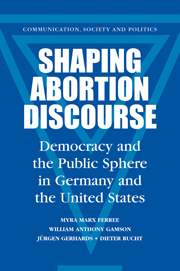Book contents
- Frontmatter
- Contents
- Tables and Figures
- Foreword by Friedhelm Neidhardt
- Preface
- Glossary
- Part I Introduction
- 1 Two Related Stories
- 2 Historical Context
- 3 Methods
- Part II Major Outcomes
- Part III Representing Different Constituencies
- Part IV The Quality of Abortion Discourse
- Methodological Appendix
- References
- Index
3 - Methods
Published online by Cambridge University Press: 15 December 2009
- Frontmatter
- Contents
- Tables and Figures
- Foreword by Friedhelm Neidhardt
- Preface
- Glossary
- Part I Introduction
- 1 Two Related Stories
- 2 Historical Context
- 3 Methods
- Part II Major Outcomes
- Part III Representing Different Constituencies
- Part IV The Quality of Abortion Discourse
- Methodological Appendix
- References
- Index
Summary
Our research findings are based on an unusually complicated data set, using multiple methods, including content analysis of newspapers and organizational documents, a survey of organizations, and intensive interviews. In this chapter we attempt to provide the general reader with enough information to assess its strengths and limitations. Important details for those with methodological interests are relegated to an appendix and to the Web (www.ssc.wisc.edu/abortionstudy).
THE CONTENT ANALYSIS
Our two major outcome variables – standing and framing – are both based on a content analysis of two major newspapers in each country. In the United States, we sampled The New York Times (NYT) and The Los Angeles Times (LAT); for Germany, we sampled the Frankfurter Allgemeine Zeitung (FAZ) and the Süddeutsche Zeitung (SZ). These newspapers are similar in targeting a national rather than a more regional audience and in being oriented toward policy-making elites. While they all cover national news, the papers we chose in each country also cover different geographical regions, giving us a way to pick up different local events, actors, and frames. We were not interested in differences between newspapers but in producing a data set that was independent of the possible idiosyncrasies of any single source. While we would have liked to include tabloids, TV, and magazine coverage, we discovered that many sources, particularly in Germany, were not archived as far back as we wished to go. We decided to focus on a narrower range of media for a longer period to focus on the comparative analysis of changes over time.
- Type
- Chapter
- Information
- Shaping Abortion DiscourseDemocracy and the Public Sphere in Germany and the United States, pp. 45 - 58Publisher: Cambridge University PressPrint publication year: 2002



